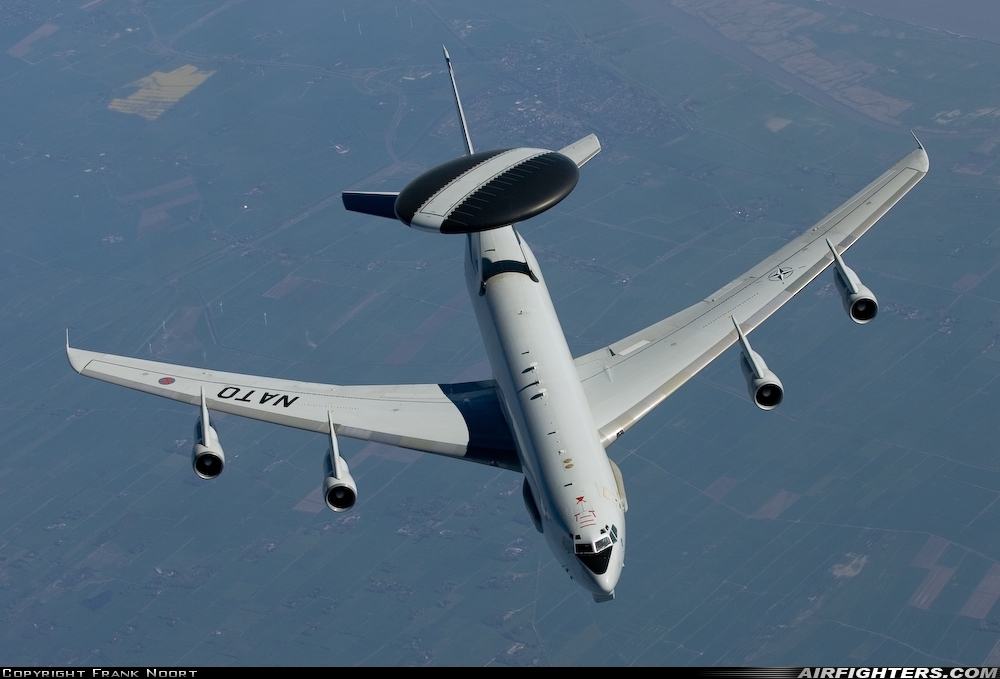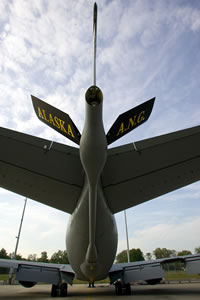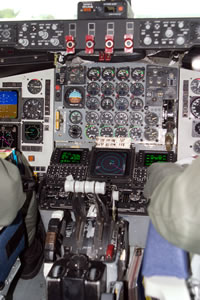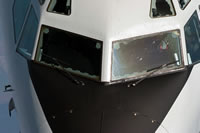For several years United States Air National Guard KC-135 Tankers have been deployed to Geilenkichen Airbase. Again, Geilenkirchen will host a number of ANG Units this year providing air-to-air refueling. Frank Noort and Arnold ten Pas were able to join a mission with the Alaska ANG taking off from Geilenkirchen to refuel two E-3 Sentry aircraft. Here an insight of such a mission plus some background on the ANG tanker deployments at this NATO airbase.
The NATO Airborne Early Warning & Control Force (NAEW&CF) was formally activated at 28 June 1982 at Geilenkirchen airbase and celebrates its 25th anniversary this year. The unit consists of personnel of virtually every NATO Air Forces and jointly they operate the E-3A aircraft with the distinctive dish on top. The NAEW&CF possesses seventeen of these sophisticated E-3As , mostly referred to as “AWACS”. Next to that, the unit also has three CT-49As for training purposes which are basically the same airframe as the E-3 but then without the radar on top. Besides that, the CT-49s are not capable of air-to-air refueling but only can make “dry” hook-ups.
ANG Tanker Deployments
| Date | Type | Unit |
|---|---|---|
| 08jan - 19jan | KC-135E | 151st ARS / TN ANG |
| 22jan - 02feb | KC-135R | 136th ARS / NY ANG |
| 05feb - 16feb | KC-135R | 106th ARS / AL ANG |
| 20feb - 02mar | KC-135R | 173rd ARS / NE ANG |
| 05mar - 16mar | KC-135R | 116th ARS / WA ANG |
| 19mar - 30mar | KC-135R | 127th ARS / KS ANG |
| 16apr - 27apr | KC-135R | 168th ARS / AK ANG |
| 30apr - 11may | KC-135R | 133rd ARS / NH ANG |
| 14may - 25may | KC-135R | 136th ARS / NY ANG |
| 28may - 08jun | KC-135R | 166th ARS / OH ANG |
| 11jun - 22jun | KC-135R | 191st ARS / UT ANG |
| 25jun - 06jul | KC-135E | 108th ARS / IL ANG |
| 09jul - 20jul | KC-135E | 108th ARW / NJ ANG |
| 23jul - 03aug | KC-135R | 121st ARW / OH ANG |
| 13aug - 24aug | KC-135R | 108th ARW / OH ANG |
| 27aug - 07sep | KC-135R | 203rd ARS / HI ANG |
| 10sep - 02sep | KC-135R | 128th ARW / WI ANG |
| 24sep - 05oct | KC-135T | 171st ARW / PA ANG |
| 08oct - 19oct | KC-135R | 186th ARW / MS ANG |
| 29oct - 09nov | KC-135R | 197th ARS / AZ ANG |
| 12nov - 21nov | KC-135R | 151st ARS / TN ANG |
| 26nov - 07dec | KC-135R | 151st ARS / TN ANG |
| 10dec - 21dec | KC-135E | 190th ARW / KS ANG |
| Credit: SGMaastricht | ||
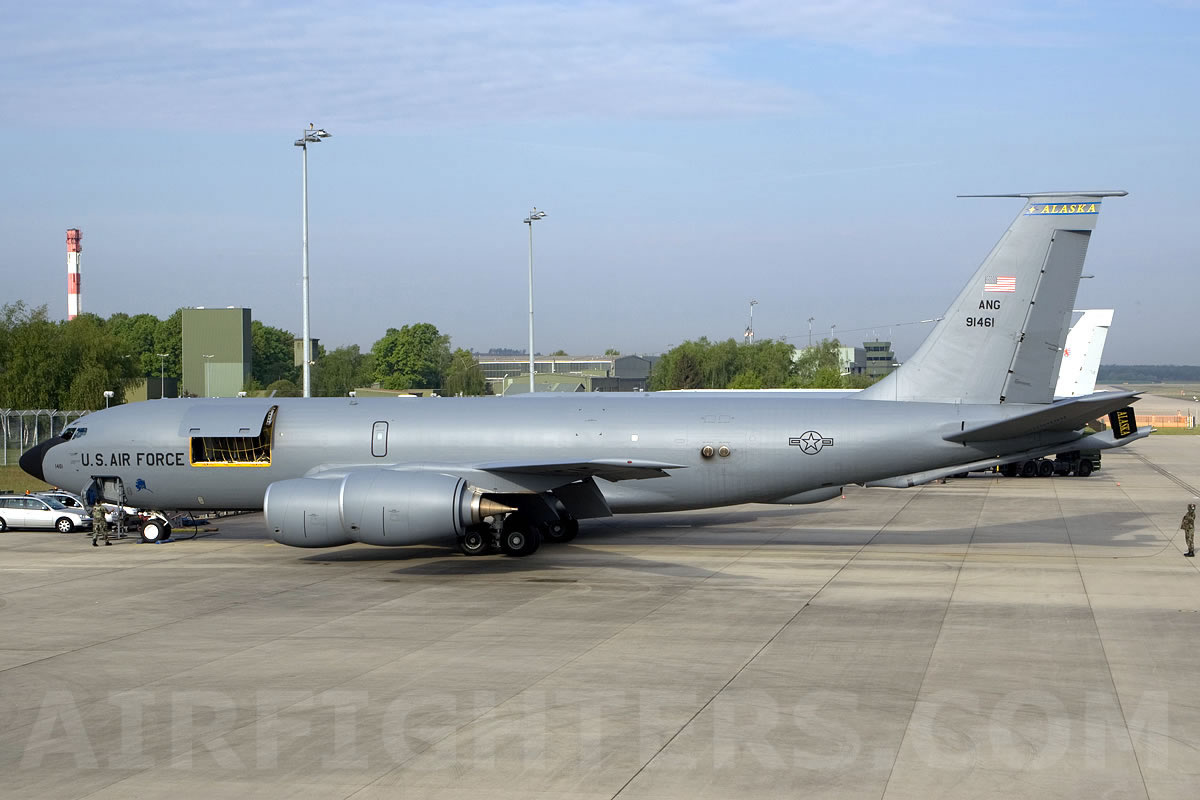
The AWACS aircraft are used to control NATO airspace around the clock and therefore the missions are long. And because of that, fuel is an absolute necessity to keep the aircraft in the air for a long period. The NATO unit in Geilenkirchen does not have its own tanker aircraft so these need to be obtained via other sources. Air to Air Refueling is not a matter of buying some tankers and simply fueling up aircraft while flying.
Air to Air Refueling is a delicate operation which needs months and months of training. For more than 14 years, through a NATO contract with the National Guard Bureau, the United States Air National Guard has been deploying aerial refueling units to provide E-3A and CT-49 crews with aerial refueling during training missions. Besides that, RAF E-3D from Waddington makes use of the ANG tankers. This year, deployment schedule in the table above applies.
Typically, the Air National Guard deploys "packages: of two KC135R Stratotankers with a small group of pilots, boom operators, maintenance, supply and other support personnel. A dedicated ANG unit, called “ANGLO”, is present at GK throughout the year. Lt Col Richard Keasey is the detachment commander and makes sure everything goes according to plan here. As we visited the deployment of the Alaska ANG at Geilenkirchen in April, we focus on one of the Tanker flight operations during that visit.
Joining mission AB5566
On Monday 16 April Chena81 and Chena82, two KC-135R Stratotankers belonging to the 168th ARS touched down at Geilenkirchen Airbase. The two aircraft with serials 58-0122 and 59-1461 were parked at the eastern side of the ramp, which is reserved for Tanker deployments and other visitors. The aircrew arriving at the airbase was surprised by the mild or even sometimes tropical climate in Germany. Compared to the cold conditions in Northern Alaska, this was something different. They were quickly told that is not normal for this time of the year but who cares. There was however not much time to be laid back and enjoy the sunshine as the busy schedule had to be carried out. Two flights a day, refueling multiple E-3A’s of the NATO wing.
We were invited to join mission AB5566 in the morning of 25 April. Expecting to be briefed at 08:00, we arrived a bit earlier at the base. The briefing was not much special, just a regular video with safety demonstrations and an instruction how to get on and off the aircraft. The KC-135 does have a small stepladder coming out of the fuselage, just behind the cockpit which makes it a bit of a challenge to climb on board with a large rucksack on. At about 09:00 we walked over to our KC-135 to meet the crew.
The 59-1461 was waiting for us in the morning sun and soon we were able to find our place in the aircraft. Space enough, because besides the crew of three people, there was nobody else but us. The aircraft itself was completely empty, just the rollers on the floor to move the cargo around and the benches on the side of the aircraft. At the back we found the Boom Operators compartment. Three seats which actually looked more like beds. You were supposed to lie down on your belly to be able to look outside of the window. The middle bed is for the Boom Operator himself, offering the best view in the house of course and, with some extra luxury, a little pod to put his chin on. In front of him two joysticks to move the boom around and some switches to stop or start loading fuel. On either side of him there was another bed, the one on the right offering a much broader view than the left one, as there is an instrument panel in the way. You can however still look outside through the main window in the middle or through the little window on the side.
 At 10:00, the engines were started and we were invited to join the crew in the cockpit. Through our headsets we could hear our captain requesting to taxi and after approval our bird, call sign Esso75, headed for runway 27. We waited a bit for NATO 08, which we allowed to take off in front of us, as this would be our first receiver. We were cleared for takeoff as soon as LX-N90451 left in front of us and we climbed out in a northernly direction. Our refuel track for today would be the “Kim Long”, situated between Hohn (most northern point) and Osnabruck (most southern point) at flight level 290. This Kim Long track, especially reserved for refueling E-3A aircraft of NATO and the E-3Ds of the Royal Air Force is 112 nautical miles long and sixteen miles wide and covers a large part of Northern Germany. As you can see on the map the route crosses the river Elbe twice which clearly can be seen from above, provided with good weather conditions, something we could expect for today.
At 10:00, the engines were started and we were invited to join the crew in the cockpit. Through our headsets we could hear our captain requesting to taxi and after approval our bird, call sign Esso75, headed for runway 27. We waited a bit for NATO 08, which we allowed to take off in front of us, as this would be our first receiver. We were cleared for takeoff as soon as LX-N90451 left in front of us and we climbed out in a northernly direction. Our refuel track for today would be the “Kim Long”, situated between Hohn (most northern point) and Osnabruck (most southern point) at flight level 290. This Kim Long track, especially reserved for refueling E-3A aircraft of NATO and the E-3Ds of the Royal Air Force is 112 nautical miles long and sixteen miles wide and covers a large part of Northern Germany. As you can see on the map the route crosses the river Elbe twice which clearly can be seen from above, provided with good weather conditions, something we could expect for today.
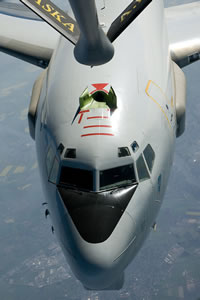 It only took a little while before we reached the track and soon we were able to overtake our white friend with the dish on top. Our Boom Operator, TSgt Cane, took us to the back on the aircraft and we took our position to wait for things to happen. Soon we could see the E-3 approaching slowly with the receiver hole open, ready for the boom. Although the weather looked nice and calm, it still quite a job to for the Sentry to approach in the right way and to get close enough for our operator to mount the boom and start loading the 15K (15000 Pound) for fuel into the receiving plane. The whole operation, training the pilots the air refueling process, connecting and disconnecting several times, took one hour at during which we covered the complete track multiple times. We have no clue how many circles we did as we did notice that both aircraft turned at the end and beginning of the track while refueling. Seen from the pictures we took, we passed the Elbe quite a few times however. After an hour, it was time for NATO08 to leave and we saw the LX-N90451 banking to the left nicely, providing us with a perfect opportunity to make some pictures. When the E-3A is positioned so close to the back window, it is quite hard to get a full shot of it, and 300 shots of the cockpit only tends to get rather boring at a certain moment. We waited for the moment of departure to get the right shot, which worked out rather well. Half an hour later, NATO06, the LX-N90454 approached us to have the same routine. This lasted an hour as well and saw many approaches and disconnections. This is quite an intensive training for the Boom operator and Sentry pilots, keeping close radio contact with each other.
It only took a little while before we reached the track and soon we were able to overtake our white friend with the dish on top. Our Boom Operator, TSgt Cane, took us to the back on the aircraft and we took our position to wait for things to happen. Soon we could see the E-3 approaching slowly with the receiver hole open, ready for the boom. Although the weather looked nice and calm, it still quite a job to for the Sentry to approach in the right way and to get close enough for our operator to mount the boom and start loading the 15K (15000 Pound) for fuel into the receiving plane. The whole operation, training the pilots the air refueling process, connecting and disconnecting several times, took one hour at during which we covered the complete track multiple times. We have no clue how many circles we did as we did notice that both aircraft turned at the end and beginning of the track while refueling. Seen from the pictures we took, we passed the Elbe quite a few times however. After an hour, it was time for NATO08 to leave and we saw the LX-N90451 banking to the left nicely, providing us with a perfect opportunity to make some pictures. When the E-3A is positioned so close to the back window, it is quite hard to get a full shot of it, and 300 shots of the cockpit only tends to get rather boring at a certain moment. We waited for the moment of departure to get the right shot, which worked out rather well. Half an hour later, NATO06, the LX-N90454 approached us to have the same routine. This lasted an hour as well and saw many approaches and disconnections. This is quite an intensive training for the Boom operator and Sentry pilots, keeping close radio contact with each other.
When NATO06 left us, it was time for us to return to base. Landing was smooth and moments later we found ourselves on Geilenkirchen again, enjoying the lovely weather and the great experience of this flight. We would like to thank all the people from 168th RS, especially Capt. Kelly Mallard and the Lt Col Keasey from ANGLO to make this possible.

